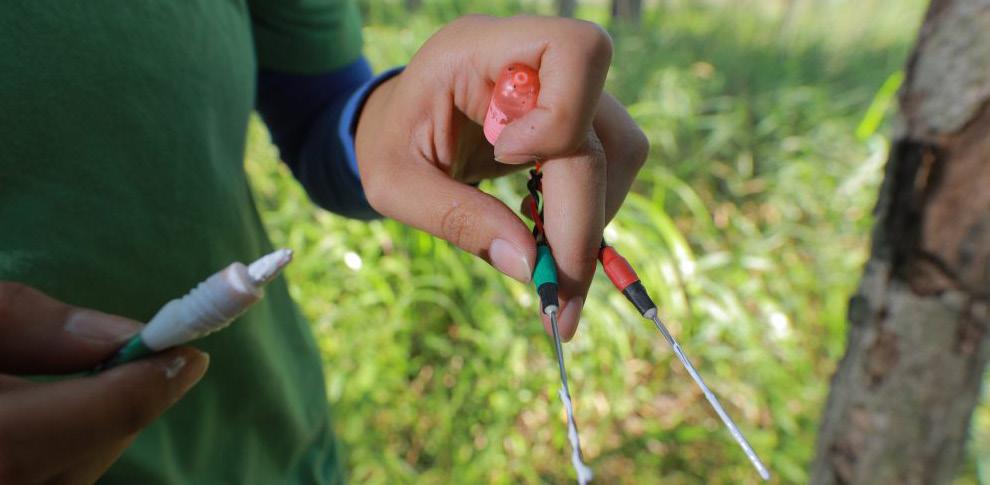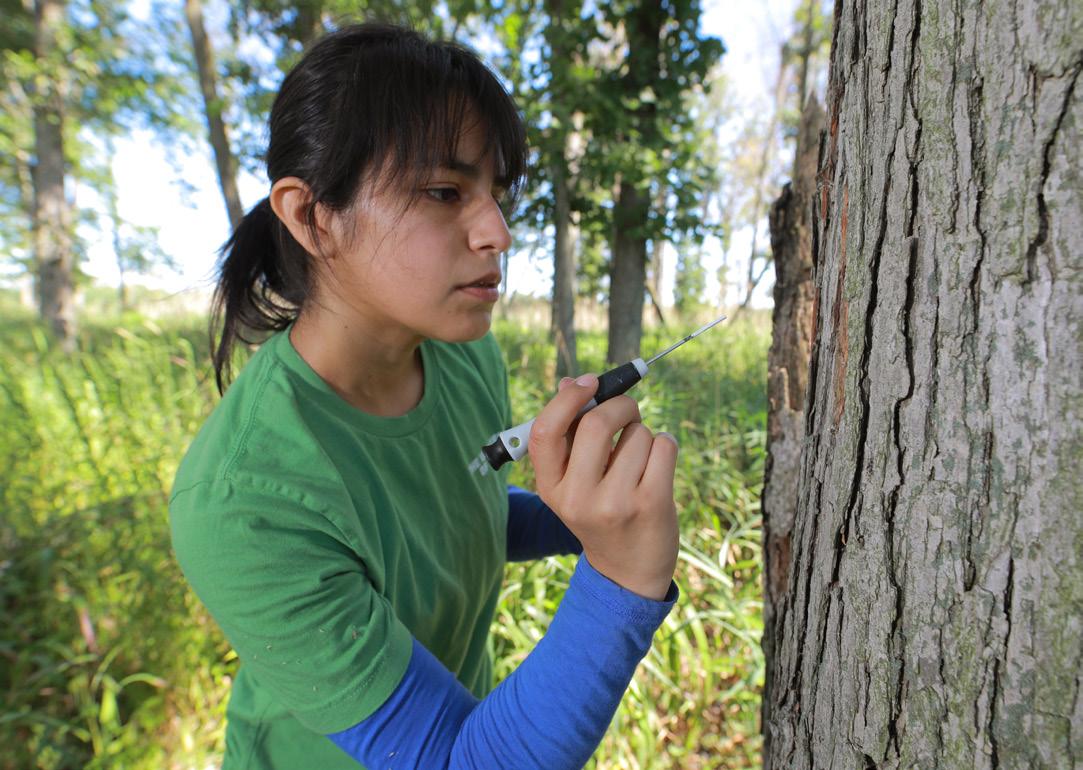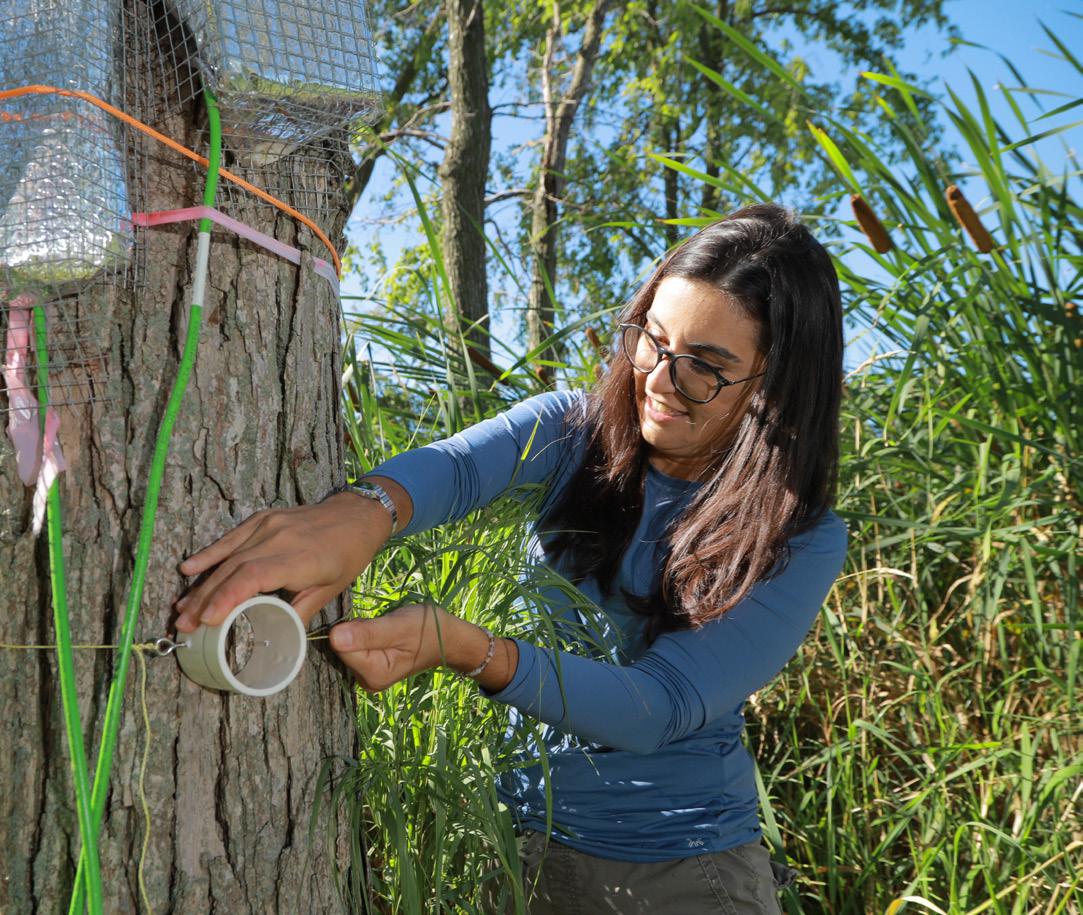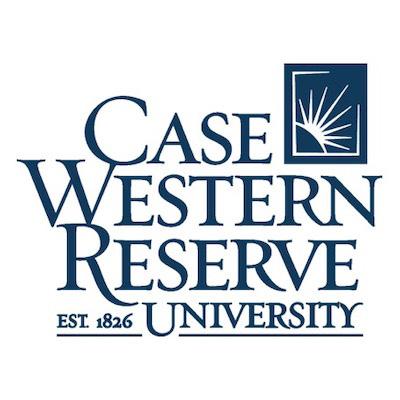
 Photo: Miami University
Photo: Miami University


 Photo: Miami University
Photo: Miami University

People often assume that fall is when higher education returns to its “busy season,” with students back in their classrooms, a new school year getting under way, and campuses bustling with activity.
But when it comes to preparing students for a successful future and ensuring that the high-demand jobs across our state are filled by skilled workers, there really is no down time.
This issue of ConnectED shows that the effort to prepare Ohio’s students for success in an ever-changing world is ongoing – and begins before they finish high school. Sinclair College hosted more than 150 high school students during Manufacturing Day to help them learn about and spark their interest in today’s manufacturing careers.
Elsewhere, tomorrow’s scientists at Case Western Reserve University and the University of Toledo are getting learning opportunities through collaborations and partnerships. Bowling Green State University announced the creation of a new school that merges high-demand and rapidly growing career fields – engineering and aviation. And a new entry-level adult training program in automation and robotics is being developed at C-TEC of Licking County thanks to a grant from the Central Ohio Manufacturing Partnership.
When it comes to looking toward the future and keeping Ohio’s economy thriving, there is never a time when our campuses and employers aren’t ConnectED.
160 high school students participated in hands-on manufacturing activities to spark their interest
BGSU Announces New School of Engineering, School of Aviation
School will enhance education opportunities for current and future students and respond to workforce needs in Ohio and beyond
Entry-level adult training program to be a model for other Ohio Technical Centers







Sinclair College and FastLane hosted Manufacturing Day on October 7, 2022, with 160 high school students participating in hands-on activities to spark interest in exciting, rewarding careers in manufacturing.

Students and staff from five high schools in Clark, Greene, Miami, Montgomery, and Warren counties converged on Sinclair’s Dayton campus to tour classrooms and labs, hear from manufacturing industry representatives, meet faculty, and learn about internship and employment opportunities in advanced manufacturing. Sinclair’s 2022 Manufacturing Day highlighted education and career opportunities in biotechnology, computer sciences and information technology, electronics & robotics, engineering & engineering technology university transfer, manufacturing & industrial engineering technology, mechanical engineering technology, and HVAC-R.
“Manufacturing Day is an incredible opportunity to expose young








Manufacturing Day is an incredible opportunity to expose young people to rewarding careers in advanced manufacturing.


people to rewarding careers in advanced manufacturing that provide excellent pay, stability, clean environments, and advancement opportunities,” said Karl Hess, Dean – Sinclair College Science, Mathematics and Engineering Division. “This event aligns with Sinclair’s mission to find the need and endeavor to meet it by providing exceptional education and training to prepare students with the skills they need to fill the growing workforce demands of advanced manufacturing employers throughout the Dayton region.”
This year, Sinclair College partnered with FastLane that specializes in solutions for manufacturing and engineering companies.

































































































“Workforce development is the biggest need in manufacturing today and by engaging high school students early on, we can expose them to the many benefits of careers in advanced manufacturing,” said April Vanover, Workforce Development & Community Outreach Lead –FastLane. “U.S. manufacturers face a potential shortage of 2.4 million skilled workers by 2028, and FastLane is committed to working with employers and education partners to build the workforce now and in the future.”
Manufacturing Day is manufacturing’s biggest annual opportunity to inspire the next generation to start careers in modern manufacturing through a series of focused events to promote manufacturing to students, parents, and educators on the first Friday of October continuing throughout the rest of the month. Manufacturing Day is an initiative of The Manufacturing Institute, with the Fabricators & Manufacturers Association as a founding partner.
School districts participating in Manufacturing Day are part of Sinclair’s FlexFactor Program. In the spring of 2021, Sinclair College began collaborating with area K-12 school districts to offer FlexFactor. FlexFactor, developed by NextFlex, is an outreach, recruitment, and STEM education program designed to familiarize K-12 students with advanced manufacturing technology, entrepreneurship, and the education and career pathways that can lead to a STEM career. Since February 2021, seven high schools with a total of 215 students, divided into 67 teams, have participated in the FlexFactor programming with Sinclair College.

The Bowling Green State University Board of Trustees recently approved a landmark change to the University’s College of Technology, Architecture and Applied Engineering (CTAAE) that will both enhance education opportunities for current and future BGSU students and respond directly to workforce needs in Ohio and beyond.
The board passed a reconfiguration of the college that will create the School of Engineering and the
School of Aviation. The reconfigured CTAAE will be composed of the new School of Engineering, School of Aviation and the existing School of the Built Environment.
The creation of a School of Engineering builds upon what BGSU already does well: its engineering technology programs hold accreditation from ABET (Accreditation Board for Engineering and Technology), and the University’s excellence in
math and science allows BGSU to become a major player in addressing a significant workforce need for qualified engineers, particularly in Ohio.
The changes will also allow the nationally recognized BGSU Aviation program to continue its rapid growth. Recently ranked No. 4 in the nation by FLYING Magazine, the BGSU Aviation program will be housed in the new School of Aviation, allowing the program to better serve students and meet industry demand.
"With the creation of the new School of Engineering and the School of Aviation, BGSU is positioned to meet the critical workforce needs of Ohio and beyond," said BGSU President Rodney K. Rogers. "As a public university for the public good, we are steadfast in our commitment to creating and enhancing relevant academic programs that provide opportunities for our students and for the public."
The demand for professionals with science, technology, engineering, and math (STEM) educational backgrounds will continue to grow in the future. According to the U.S. Bureau of Labor Statistics, most engineering careers are expected to grow at rates that exceed 10% between 2020 and 2030, and STEM job growth is expected to nearly
triple non-STEM job growth during the same time frame.
Within the region, there is also a significant need for professionals in logistics, health care, advanced manufacturing, and other STEM-related fields to sustain growth.
Enhancing and converting existing technology programs into engineering programs will enhance enrollment, and address workforce needs by supplying well-prepared graduates in areas of significant need.
Earlier this month, U.S. News & World Report ranked BGSU’s engineering programs among the best in the nation in its 2022-23 Best College rankings. The reconfiguration of CTAAE will allow BGSU the opportunity to explore additional engineering programs in the future, pivot quickly in response to industry needs, provide advancement opportunities for curriculum development with subject matter experts, expand opportunities for high-impact research and meet projected growth before it happens.
Three existing technology programs will move into engineering programs that will be housed within the School of Engineering, including mechatronics engineering technology, which will

be converted to robotics engineering; mechanical and manufacturing engineering technology, which will be converted to mechanical and manufacturing engineering; and electronics and computer engineering technology, will be converted to electronics and computer engineering.
All three programs will award a Bachelor of Science in Engineering after the conversion, which is currently underway.
BGSU, which is now home to the largest aviation program in the state of Ohio, is committed to continued investment in aviation. Thanks to a public-private partnership with North Star Aviation, BGSU debuted a $5 million expansion of the Bowling Green Flight Center in June, and now will make the School of Aviation a reality within CTAAE.
BGSU Aviation has experienced booming growth – by the 2021-22 academic year, the number of students and staff tripled from seven years earlier –and current projections indicate aviation will only continue to grow.

According to the U.S. Bureau of Labor Statistics, demand for pilots, both commercial and airline, is expected to rise 13% by 2030, while aviation management is expected to grow 6%. Even before expected future growth, the demand for pilots is not being met now, either in Ohio or nationwide.
Initially, the School of Aviation will offer Bowling Green’s existing Bachelor of Science in Aviation degree, with specializations in Flight Technology and Operations and Aviation Management and Operations. Program updates are currently underway that will allow BGSU to offer two Bachelor of Science degrees in Flight Technology Operations and Aviation Management. With the many opportunities provided for students at BGSU – one of the few universities with an airport located on its campus land – the university is uniquely positioned to train the aviators of tomorrow.
With the many opportunities provided for students at BGSU – one of the few universities with an airport located on its campus land – the University is uniquely positioned to train the aviators of tomorrow.
"To best prepare our graduates for an ever-changing workforce, BGSU puts a premium on the success of
our students," said Joe B. Whitehead, provost and senior vice president for academic and student affairs. "The time is right for BGSU Aviation to become its own school within CTAAE, and the changes will only enhance the experience for our students and give them additional opportunity to succeed when they graduate."
With the two new schools, all of the college's programs will now be housed in one of three schools within the CTAAE, providing collaborative and industry-focused curriculum. The college has an alreadyestablished School of the Built Environment for its construction management and architecture programs.
Earlier this year, the majority of faculty and staff overwhelmingly passed a resolution in support of the reconfiguration.
“These changes will continue to open doors for our students, while at the same time aiding our region by meeting its workforce needs,” said Dr. Jennie Gallimore, professor and dean of CTAAE. “Creating both schools will increase the visibility of BGSU, better address the needs of both students and the workforce and support the overall mission of the university by doing public good from the ground up.”
All academic programs within the Department of Engineering Technologies (DET) and Department of Visual Communication Technology & Education (VCTE) will be housed in the School of Engineering except for Aviation, which will be housed in the School of Aviation.
Degree pathways for current students within the college will be uninterrupted by the reconfiguration.
Three existing technology programs will move into engineering programs that will be housed within the School of Engineering, including mechatronics engineering technology, which will be converted to robotics engineering. (BGSU photo/Craig J. Bell)

Entry-level adult training program to be a model for other Ohio Technical Centers
The Central Ohio Manufacturing Partnership (COMP) awarded C-TEC of Licking County’s Adult Education Center the federal Industry Sector Partnership Grant. This grant allows C-TEC to lead Central Ohio in developing an entry-level automation and robotics adult training program.

The goal of the grant is to develop entry-level curriculum in manufacturing automation and robotics that will supply a steady pipeline of automation technician workers. The short-term certification program will be less than one year. C-TEC developed the model, in partnership with Licking County and Central Ohio manufacturers, and will train the first class of students who will be awarded full scholarships as part of the initiative.
From there, C-TEC will assist other Ohio Technical Centers in surrounding counties to implement similar programming. C-TEC was selected because of its competitive advantage in equipment, technical expertise, and community partnerships. Experience in industry

training models specific to manufacturing helped make C-TEC a natural choice to activate this initiative. In October 2020, with the help of local manufacturers, C-TEC launched its new Advanced CNC Machining and Robotics Integration program that includes a new 120hour Robotics and Automation course with national industry certification in Fanuc Handling Pro.
“We’re excited to keep building on our work in automation and robotics so that C-TEC can continue to respond to workforce challenges,” said Lauren Massie, C-TEC’s adult education director.
Shawn Hendrix, COMP president and president of Nissen Chemitec America, Inc., said, “Manufacturing is the largest economic sector in Ohio, and the investment in automation by manufacturers is vitally important to remain globally competitive, and absolutely necessary to sustain manufacturing in our state.
“The Central Ohio Manufacturing Partnership awarded this grant to C-TEC to develop an
entry-level automation program with full confidence that they will deliver an outstanding program based on the resources that they currently have in their facility along with an experienced and committed staff,” Hendrix added. “This program will be a model that we intend to eventually deploy to the other Ohio Technical Centers.”
COMP is a manufacturing-led industry sector partnership created to solve the workforce training, retention, and recruitment challenges of its participating membership, which includes many Central Ohio-based manufacturers. The COMP membership includes manufacturing and educational firms in Delaware, Fairfield,

Franklin, Knox, Licking, Logan, Madison, Marion, Morrow, Pickaway, and Union counties.
The new automation program launched in June 2022. For more information on the new Advanced CNC Machining and Robotics Integration program, go to https://www.c-tec.edu/page/advanced-cncmachining-and-robotic-integration.

Leticia Sandoval lost another one. Four dead in just six months. “They don’t look like the picture of health, but I didn’t expect to lose so many in the first year,” she said.

As part of one of the largest coastal research projects ever funded in the U.S., the graduate student at The University of Toledo is witnessing the spread of ghost forests along the Great Lakes, haunted by a decade of rising water levels and climate change wreaking havoc on trees.

“I’ve always loved living in Toledo and near the Great Lakes,” said Sandoval, who is working toward a master’s degree in biology. “I have a lot of family here. I like the changing seasons. And I think it’s a great place to live due to climate change. I think people who move to Florida or California are crazy. That used to be the glamorous place to live but now I’m worried about them.”
Opening her eyes to a shrinking oasis in her own back yard, her high-tech UToledo field work includes creating wireless wetlands, uplands, and coastal forests as an important part of the U.S. Department of Energy’s $20-million COMPASS Project examining the delicate dance between vegetation, soil, and hydrology.
COMPASS, which stands for Coastal Observations, Mechanisms and Predictions Across Systems and Scales, zeroes in on two regions: western Lake Erie and the Chesapeake Bay. One is freshwater and one saltwater.
UToledo leads the Great Lakes piece of the federal project headed overall by Pacific Northwest National Laboratory. The Smithsonian Environmental Research Center (SERC) leads the Chesapeake Bay portion.
“In environments like the Great Lakes it’s raining more these days than it was 50 years ago, and more of that rain is coming in the form of big, intense storms,” said Dr. Michael Weintraub, a professor of soil ecology at UToledo and coprincipal investigator of COMPASS. “Due to rising water levels over the past decade, areas that used to be dry land and had plants that grow on dry land are now completely under water. One of the consequences is, without oxygen, microbes wind up producing methane, which is about 30 times more potent as a greenhouse gas than carbon dioxide.”
Right now, scientists can’t predict how changes in climate and water levels are going to affect the exchange of greenhouse gases with the atmosphere in coastal environments.
The goal of COMPASS is to collect data to develop new and improved ecosystem models that will help forecast how these systems will function under conditions that humans have never seen before.
“Very much like trying to understand the health of an organism, like a human being, we’re trying to understand the physiology of this ecosystem,” Weintraub said. “For example, how are the plants functioning? What happens to plant function when plants get stressed by flooding? We have tapped into the veins of trees and we’re measuring sap flow and how sap flow responds to things like flooding.”

Stationed in the Ottawa National Wildlife Refuge along Lake Erie about a 30-minute drive from UToledo’s Main Campus, Sandoval is in charge of tree sensors at several


sites from uplands into wetlands. Focused on sap flow, she monitors water and energy movement from underground to the canopy of trees.
Though she can remotely access the continuous measurements uploaded every 15 minutes to a data archive, Sandoval needs to go back out and drill into a new tree every time one of her study trees dies.
“I put a metal tube in there and then a sensor goes inside the tube that’s inside the tree,” she said. “It’s a paired system. There’s two holes; one lower and one higher. The sensor on the bottom is heated. The difference in the heat between them tells you the velocity of the sap flow.”
Just like when a hospital monitor shows no brain waves or heartbeat, the graduate student researcher sees the rising water levels killed another tree when the graph flatlines.
“You know it’s dead when it’s not moving sap during the growing season,” Sandoval said.
Monitoring a once-verdant woodland as it transforms into a ghost forest of dying timber, she is working alongside a team of UToledo faculty researchers, post-doctoral researchers and technicians and scientists from the U.S. Department of Energy’s national laboratories and SERC.

“The summer along Lake Erie was hotter than I imagined,” said Dr. Roberta Peixoto, a postdoctoral researcher at UToledo from Brazil who is in charge of measuring the greenhouse gas coming out of the ground at the marsh.
Peixoto and her husband, Dr. Fausto Silva, also a post-doc at UToledo, moved their family to Toledo

in March specifically to work with the University on the COMPASS project.
They explain to their 2-year-old and 5-year-old children that they are performing medical checkups on nature.
“In COMPASS, we are nature’s doctors,” Peixoto said. “We are trying to understand whether coastal forests are sick due to water level changes, feeding models with crucial data for climate forecast. We measure tree health to discover the mechanisms involved in the loss of vegetation.”
Peixoto, who earned her master’s degree and doctorate at the Federal University of Rio de Janeiro, is deploying equipment about the size of a briefcase that measures what’s called greenhouse gas flux in real-time out in the field.
It’s the same work she did in the Amazon rainforest that resulted in several groundbreaking discoveries, including that flooded forests in the Amazon are important, overlooked methane emitters via tree stems.
“Methane is a greenhouse gas with a larger capacity of global warming than carbon dioxide,” Peixoto said.
She places chambers in the soil or wraps them around tree stems and connects those chambers to an infrared gas analyzer using gas-tight tubes. The technology can quantify greenhouse gas such as carbon dioxide and methane. This tool allows her to calculate greenhouse gas fluxes and monitor how flooding is affecting different processes in the field such as microbial respiration in the soil, plant growth or the transport of gases through tree stems.
Though she and her husband, who met in Brazil during their Ph.D. studies 10 years ago, monitor different things at Ottawa National Wildlife Refuge along Lake Erie’s coastline, their research complements each other.
Silva collects water quality data. For example, he sticks tiny tubes down into the ground and draws water samples from underground.
“He is monitoring the oxygen concentration, pH and redox potential in soils and groundwater, which are all control factors of the greenhouse gas emissions that I am monitoring,” Peixoto said. “Any small changes in these parameters because of drought or flooding conditions will directly interfere in the production of greenhouse gas and consequently in their fluxes to the atmosphere.”

“From the top of the trees to the bottom of the water table, there’s a lot going on,” said Dr. Solomon Ehosioke, a postdoctoral research associate and geophysicist at UToledo. “I’m interested in the soil and groundwater processes, as well as the exchanges between soil, water and plant roots.”
The native of Nigeria, who earned a Ph.D. in engineering and technology sciences from the University of Liege in Belgium and his master’s degree in hydrogeology and environmental

geosciences from the University of Goettingen in Germany, is leading a geophysics team looking at surface and underground conditions of the soil to understand how the soil property changes from the land toward the lake.

They run an 84-meter-long cable, about the majority of a football field, with little electrodes sticking into the ground.
“Using a resistivity meter, we inject an electrical current into the soil up to 19 meters deep and get feedback in terms of how the soil materials interact with the electrical current,” Ehosioke said. “From there we can infer the properties of the soil at different depths without the need to dig the ground and disturb the natural processes taking place.”
That data combined with soil analysis and groundwater investigations will help the team understand how the flow of groundwater controls changes in soil properties, and the different processes happening in the wetland such as microbial growth, greenhouse fluxes, and redox potential changes.
“It’s nice to work with other people with different backgrounds because we complement each other in

terms of our expertise and encourage the sharing of information, which is helpful to better understand our data from diverse perspectives,” Ehosioke said.
“We’re measuring nutrient availability to plants and nutrient cycling and decomposition and microbial activity because that controls the production of these greenhouse gases that we care about,” Weintraub said. “And we’re also studying the hydrology because water level fluctuations are so important for controlling what plants are growing there. Too much flooding, you’re going to lose all the trees and other woody plants.”
UToledo used COMPASS federal funding to expand environmental expertise by hiring faculty and staff specifically for this project, including Dr. Inke Forbrich, an assistant professor and wetland biogeochemist, and Matt Kovach, wetland field site specialist.
Kovach maintains site infrastructure. A combination of a wilderness carpenter and electrician, he is constantly trying to MacGyver things to keep solar panel arrays and data network functioning while battling rodent populations that keep chewing the cables.
“We have an army of people involved in this project, and it really does provide tons of opportunities for our students, too, including undergraduates,” Weintraub said. “Studying wetlands and collecting all of this information on how the plants and soil are functioning and what the hydrology is doing involves a lot of long days in hot, sunny wetlands often in very wet, muddy conditions.”
Before setting up equipment and starting to collect data over the summer, the teams worked together beginning in March to construct boardwalks to be able to regularly access wet areas without continually disturbing the environment with their footsteps.
To get to their test sites, they traverse what looks like a balance beam, carrying heavy equipment above the swamp.
To make matters more interesting, many areas are encased in cattails taller than some researchers’ heads.
Though most of the time spent in the field this summer has been 80 degrees and humid, most wear long sleeves to protect against mosquitoes, sunburn and getting scratched — something Peixoto remembers having to do in the Amazon too.
“Imagine doing this in a thicket of rose thorns because that’s what we’re talking about at one of our primary research sites. This is incredibly hard work that our students literally pay for with their blood, sweat, and tears,” Weintraub said. “But the students are so excited about the opportunity, and they are getting to work with scientists from all over the country. They’re getting to go to national labs and SERC.”

For Peixoto and Silva, the married scientists from Brazil, the ability to use their high-tech environmental experience to understand a part of the world farther away from the equator is a way to give their children a brighter future.
“Our kids were one of the reasons we decided to move to Toledo,” Peixoto said. “We were looking for a nice place where we could enjoy more nature far from the big cities like Rio de Janeiro. I really believe as scientists we have to take the opportunity of showing the world to our kids. When they spend time with us from remote areas in the Amazon to the Great Lakes in Ohio, they can connect with nature in different ways and understand how everything is connected in our planet.”
Sandoval, a UToledo graduate student, worked at Metroparks in Cleveland and Toledo and at state parks in Virginia through AmeriCorps after she
graduated with her bachelor’s degree from Ohio State University, but described COMPASS as the highest-level modern science with collaborating researchers from around the country who motivate her to become a great scientist during a time of environmental upheaval.
“They’ve been in my shoes before as they built their careers, so I’m lucky to have their guidance and access to such advanced equipment,” Sandoval said. “I’ve worked with a lot of invasive species before, so native species I don’t want to see dying. But it’s better to study them, though it’s not good to see the trees die before my eyes.”
“Are trees going to come back? We don’t know. We can’t predict that yet,” Weintraub said. “We don’t really know what water levels are going to do in the future. Are these systems going to be flooded? Are they going to experience drought? We are just getting warmed up. This is envisioned as a 10-year, national-scale effort. And we’re in on it from the beginning.”




Forge Biologics, a gene therapy-focused contract development and manufacturing organization (CDMO), has launched the Forge Forward gene therapy workforce development program in partnership with the National Center for Regenerative Medicine (NCRM) at Case Western Reserve University (CWRU). The goal: to train and attract top talent with specialized Good Manufacturing Practice (GMP) training to the company.
“The gene therapy manufacturing boom has created an unmet workforce demand whose training will be foundational for the success of the gene therapy industry. We are especially excited to be partnering with the NCRM to help expand the talent pool of trained gene therapy manufacturers in the Midwest,” said Timothy J. Miller, chief executive officer, president and co-founder of Forge.
The inaugural Forge Forward program will help build and extend Ohio’s leadership in gene and cell therapy manufacturing by enrolling promising students wishing to learn the basics of gene therapy manufacturing. Selected candidates will learn how to work in both research and GMP environments and will gain hands-on experience in cell culture and sterile techniques through both lecture and laboratory teaching.
“The NCRM training environment offers a unique opportunity to respond adeptly to the needs of the regenerative medicine biotechnology industry of the state. We welcome the opportunity to work together to train an outstanding work force,” said Stan Gerson, interim dean of Case Western Reserve’s School of Medicine and NCRM director.
The Forge Forward internship initiative will integrate the experience of NCRM and the Master’s of Regenerative Medicine and Entrepreneurship (RGME), enhancing the educational and experiential exposure to gene therapy technology, manufacturing and clinical development. The goal of the hands-on education program will be to streamline the industry’s workforce development, providing dozens of opportunities for both internship participants and Forge Biologics.
“This program has the potential to provide the experiential learning our students want and the specific skills they need for employment in this rapidly growing field,” added Cheryl Thompson, associate professor and assistant dean of educational initiatives for the School of Medicine.
